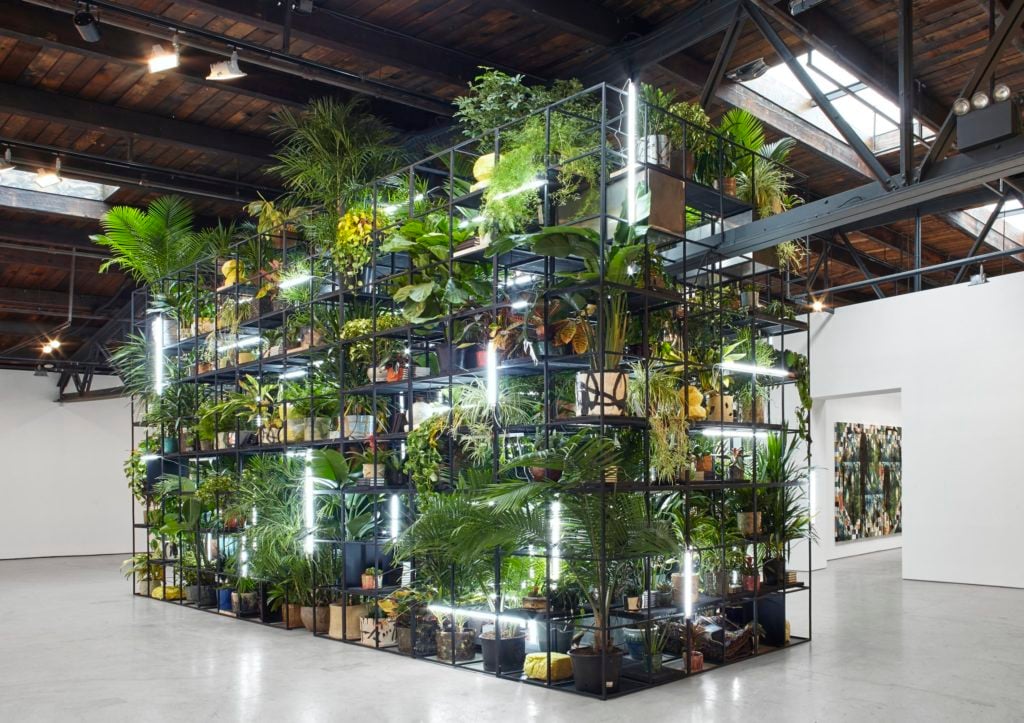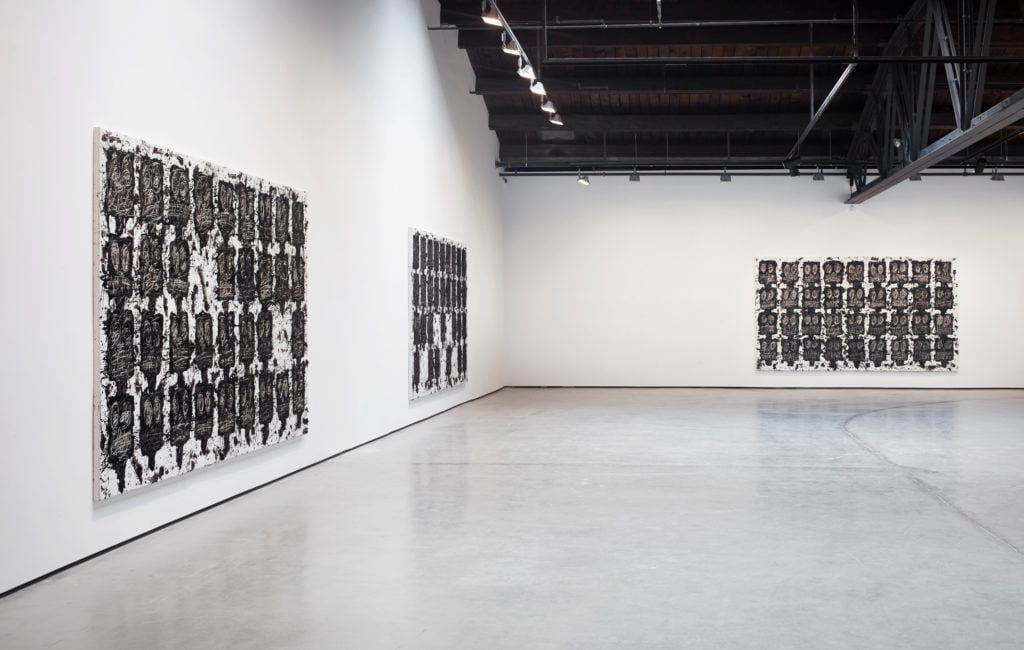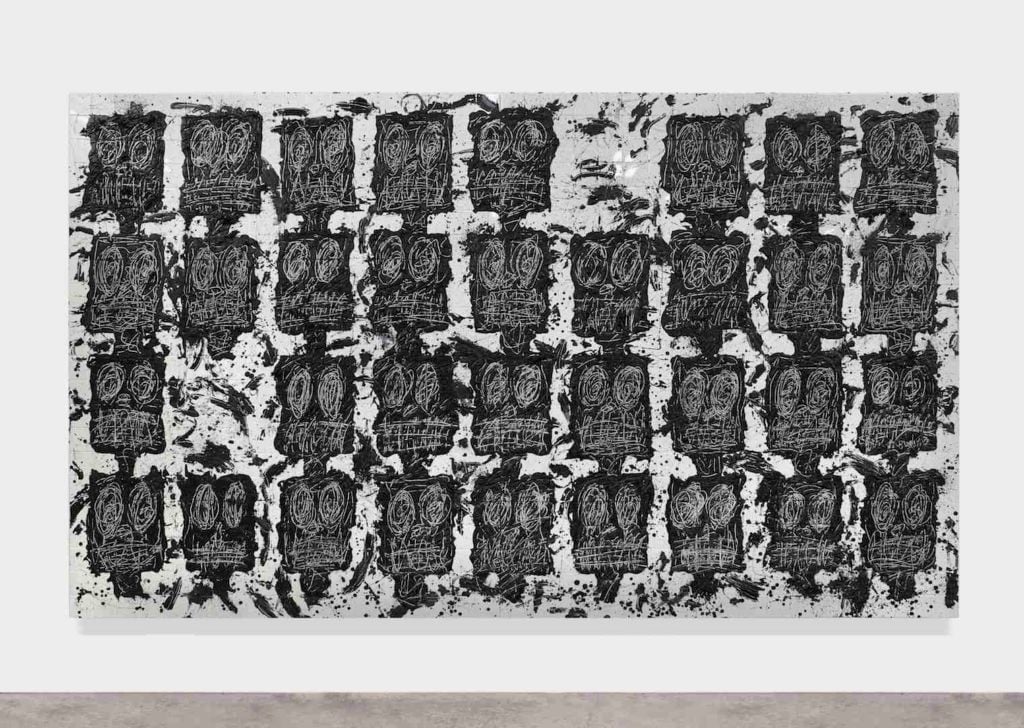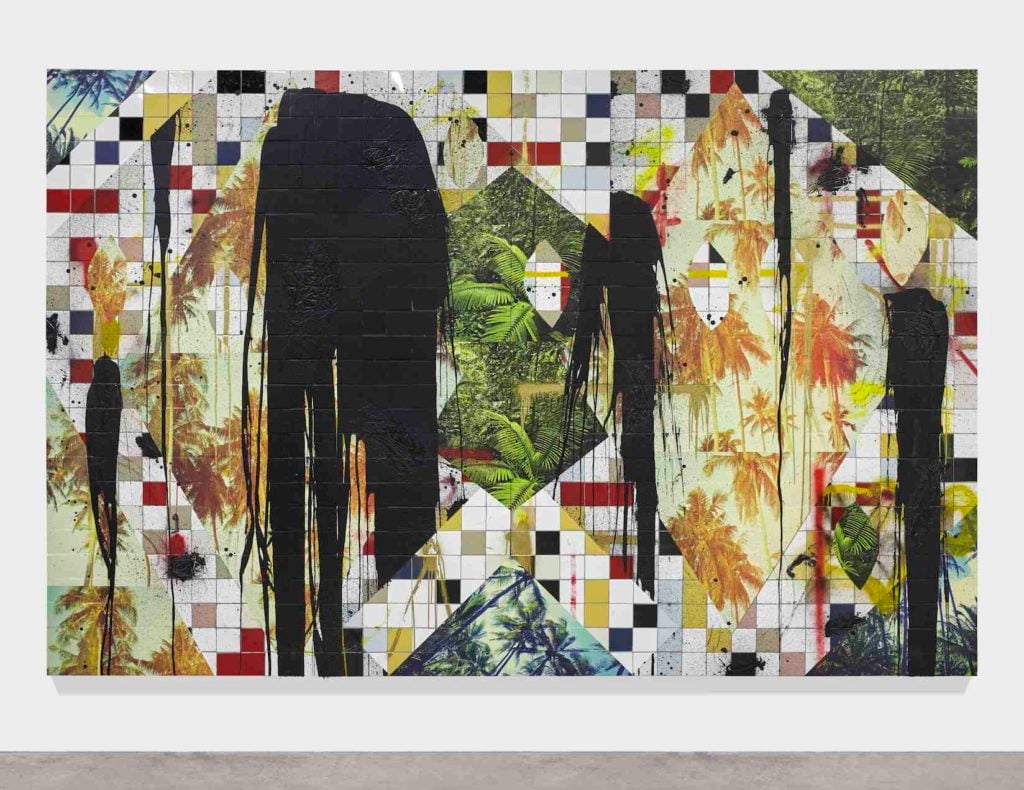Reviews
Rashid Johnson Takes Post-Black Art to Pleasure Town
The artist takes on Hauser & Wirth’s cavernous 18th Street space, and succeeds.

The artist takes on Hauser & Wirth’s cavernous 18th Street space, and succeeds.

“I would like to see Abe Lincoln about this equality bullshit.” That brassy line was uttered in 1970 by comedian Godfrey Cambridge, who played an average-white-guy-turned-black-dude in Melvin Van Peebles’ dramedy Watermelon Man—a picture inspired, in part, by Franz Kafka’s Metamorphosis.
Forty-six years later, the spirit of that complaint lives on. Michelle Obama invoked it in her electrifying Democratic Convention speech by acknowledging that—surprise—the White House was built with slave labor. Also chiming in over the years: black artists of every stripe and discipline.
Prominent among visually oriented folks within a much larger group of remonstrating artistes—think everyone from Beyoncé to Ta-Nehisi Coates—is collagist, sculptor and installation maven Rashid Johnson. Part of the original “post-black” crew rounded up by curator Thelma Golden for the Studio Museum’s landmark 2001 “Freestyle” exhibition, Johnson at once embraced and rejected the Civil Rights-era expectations attached to becoming that rare unicorn—the successful African American artist.
From the Studio Museum to his current exhibition at Hauser & Wirth’s cavernous 18th Street space, Johnson has consistently used his work to confront the nation’s legacy of racism head on. Together with other members of his historical cohort, he has also helped rewrite the script for how to become a 21st century African American artist. Among that script’s evolving guidelines are a marked preference for complexity over uplift, a penchant for contradiction over authenticity, and, most recently, a newfound willingness to tackle urgent political causes and prominent social movements. On the evidence, post-black art today is far more attuned to the Black Lives Matter movement than to Cornel West’s 1994 bestseller Race Matters.

Installation view, ‘Rashid Johnson, Fly Away’. Photo: Martin Parsekain. All images © The artist. Courtesy Hauser & Wirth.
Though Johnson has long sought to redefine and reinterpret changing notions of blackness—i.e., the most cussed version of Americanness—his messily poignant works retain the tendency to use individual and family history as jumping off points to examine the black experience. Recently, though, the artist’s efforts have taken a more communal turn. Where previous shows have highlighted questions of selfhood and individual anxiety as artistic themes (cue last year’s aptly titled “Anxious Men” at the Drawing Center), his current exhibition—which consists of nine “paintings,” three wall-mounted sculptures, a freestanding volumetric arrangement and a large installation—doesn’t merely reference America’s racial dilemma, it takes as its explicit subject timely yet universal ideas of fear and escape.
Made with the artist’s signature “Afrocentric” materials, among them black soap, shea butter, ceramic tile, mirror, and burnt wood, Johnson’s artworks manage an unlikely feat inside Hauser & Wirth’s XXXL-sized gallery. Thanks to the artist’s own exhibition design—he admitted to me to having scrapped 20 maquettes to get to the current layout—the display survives a space that has vanquished a number of other art world veterans like Dieter Roth, Paul McCarthy, and Matthew Day Jackson.
The solution to an ex-roller rink with massive ceilings and no columns, Johnson figured, were some well-placed 25-foot walls. These, in turn, divide the open architecture into a single large installation area and three discrete painting galleries. The result is akin to bug jiu-jitsu on “Animal Planet”: The artist has taken control of a stadium-like space that, like the wolf spider, has been known to eat its own.

Rashid Johnson, Untitled Anxious Audience (2016), All images © The artist. Courtesy Hauser & Wirth.
The first room in Johnson’s well-appointed exhibition—it’s titled “Fly Away” in honor of the world’s most recorded gospel song—contains six large rectangular panels made from white ceramic tiles that the artist has covered with rows of expressionistic black soap and wax figures. Rendered as a series of roughly drawn blockheads, Johnson’s bug-eyed visages invoke a multipage Google search’s worth of visual antecedents. These include, among others, Sponge Bob Square Pants, Alberto Giacometti’s Falling Man, Jean Dubuffet’s homunculi, and, of course, “pickaninny” caricatures. Titled Untitled Anxious Audience, these works present, at once, a literal depiction of crowds, and also—to paraphrase the artist—a figurative but personal and artistic transition from I to We.
A few rooms away, Johnson echoes, in inverted fashion, the figures depicted among his anxious audiences. Single portraits of upended stick men on wood and mirror backgrounds, these collaged forms mimic video game characters, flying (or plummeting) superheroes, and chalk outlines that are familiar from fictional cable and TV crime scenes. Whether encased in singed redwood or soap-stained mirror, the artist’s tumbling ciphers appear literally framed by their circumstances. Like Giacometti, Johnson also calls his figures “Falling Men.”

Rashid Johnson, Untitled Escape Collage (2016). © The artist. All images © The artist. Courtesy Hauser & Wirth.
The largest space in “Fly Away” is given over to a large cube of scaffolding that contains “signifying objects”: plants, books, video screens, mounds of shea butter, ceramic pots, and a piano, which is to be played periodically by the musician and music producer Antoine Baldwin during the run of the show. Despite the scale of this installation, it’s more modest work in another purpose-built gallery that impresses as Johnson’s biggest advance on his blustery, sometimes uneven oeuvre. These are, quite simply, three color-saturated “paintings” made from white and colored tile, black soap, spray paint and large diamond-shaped snatches of tropical-themed wallpaper that would not be out of place in your local Dominican greasy spoon.
The artist calls these works his “Escape Collages.” Rude, fresh, fantastical, complex and as culturally contradictory as anything in the post-black art pantheon, they suggest both the idea of modern-day dystopia and its radical possibilities of escape. It’s Bronx graffiti on a Jamaican subway train, hurtling toward a lushly gritty someplace that is, also, anyplace but here.